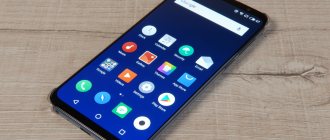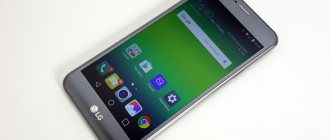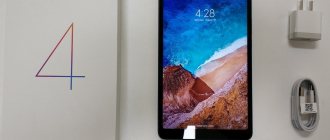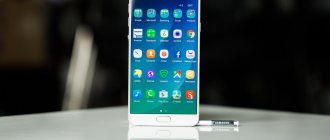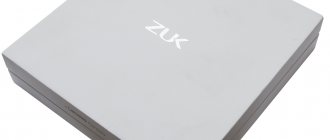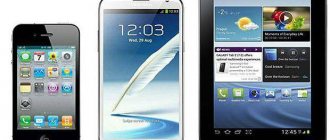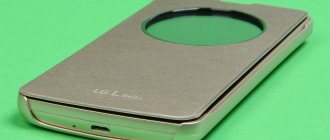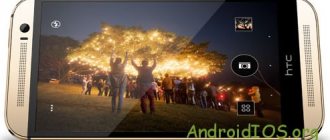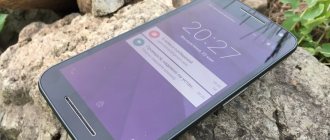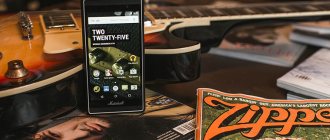Appearance and photos of the smartphone
Advantages and disadvantages of the 1X phone
Alcatel 1X measures 70.6 mm wide, 147.5 mm long and 9.1 mm thick. With such dimensions it is convenient to operate the device with one hand. In addition, the weight of the device is about 151 grams. Even if you operate the device with one hand, its weight is almost not felt.
If we evaluate the overall ease of use of the phone taking into account the size and weight, then there will be no problems with everyday use.
The smartphone is equipped with a 4-core MediaTek MT6739 processor, which is made at 28 nm. technical process.
The smartphone has only 1 GB. RAM, which is quite small. Instances of low RAM will occur regularly, so even when using light applications you will experience instability in operation.
The device's data storage capacity is 16 GB, and while this is enough for photos, it may not be enough for video shooting and a large number of games.
The phone is compatible with SD cards, so you can easily expand its memory. So you probably don't need to worry about storage capacity.
The 1X has a display diagonal of 5.3 inches. The display is large enough that you will rarely have problems with its size. However, this display is not suitable for writing long texts.
In terms of quality, the screen may appear pixelated when displaying a picture or video. It should be sufficient for normal use.
The main camera of the phone has 7.99 megapixels, which should be enough in most cases. However, you may be slightly unsatisfied with the quality of the photos.
Also, the smartphone has a 5.04 megapixel front camera, which is average for smartphone cameras. This is good enough for taking selfies, but you may not be satisfied with group photos or their print quality.
The Alcatel 1X battery capacity is 2460 mAh, which is a typical capacity indicator. Compared to other smartphones, the Alcatel 1X's battery life is average. You don't have to worry about anything during daily use. However, if you spend time surfing the internet or playing games, you might be a little underwhelmed by the battery life.
Appearance
The elegant Alcatel 1 X 2020 device is available in two colors:
- Pebble Black;
- Pebble Blue.
The overall dimensions of the product are:
- width - 68.8 mm;
- height - 146.4;
- thickness - 8.3 mm.
The front panel of the device is predominantly occupied by the display, which is characterized by an aspect ratio of 18 to 9 and occupies 77.5% of its area.
The full-screen smartphone makes a favorable initial impression thanks to its modern design and comfortable placement in the hand, which is ensured by the comfortable dimensions of the classic case and the light weight of the device (130 g).
Detailed technical specifications
Make and model
Make and model of the device, and alternative names (if any).
| Brand Device manufacturer company. | Alcatel |
| Model Device name. | 1X |
| Alternative names Other model names, if available. Sometimes the model is called differently, depending on the country or because of popular nicknames. | 5059A 5059D 5059I 5059J 5059T 5059X 5059Y |
Design
Appearance of the device including dimensions, weight, volume, colors and materials.
| Width The horizontal side of the device when used in standard orientation. | 70.6 mm (millimeters) |
| Height The vertical side of the device when used in standard orientation. | 147.5 mm (millimeters) |
| Thickness The cross-sectional size of the device. | 9.1 mm (millimeters) |
| Weight How much does the device weigh excluding the case, SIM and memory cards and other additional elements. | 151 g (grams) |
| Volume Approximate value calculated using the formula: length times width times height. | 94.76 cm³ (cubic centimeters) |
| Colors What colors is the device available in? | Black Blue |
| Housing materials What materials is the body made of? | Plastic |
System on a Chip (SoC)
A system on a chip, a single-chip system (System on a Chip, SoC) is when several systems performing different device functions are connected on one chip.
| System on a Chip (SoC) A single-chip system that contains components such as a processor, graphics accelerator, memory units, communication interfaces, etc., as well as software for the operation of the system. | MediaTek MT6739 |
Central processing unit (CPU)
| Central processing unit (CPU) The main component of the device is responsible for calculations and data processing. | ARM Cortex-A53 |
| Technical process What technological process is used to make the chip? The smaller the process technology, the better - the chips consume less power and generate less heat. | 28 nm (nanometers) |
| Processor size Processor capacity is a parameter that indicates how many bits of data a processor register processes in 1 clock cycle. This is usually 32 or 64 bits. | 64 bit |
| Instruction Set Architecture Instruction set architecture (ISA) is a programmable part of the microprocessor core used by software to control the operation of the processor. | ARMv8-A |
| Number of processor cores The processor can be either single-core or multi-core. The performance of the processor depends on the number of cores (threads). The more cores working simultaneously, the higher the power consumption, so in mobile devices all cores are used only under high load. | 4 |
| CPU clock speed Clock speed is the number of operations per second that a processor or its core can achieve. The higher the frequency, the higher the overall performance of the device, but performance also depends on the processor architecture and the number of cores. | 1300 MHz (megahertz) |
Graphics Processing Unit (GPU)
| Graphics Processing Unit (GPU) The graphics processing unit (GPU) is used to process and display graphics - 3D effects, games, interfaces and other visual elements. Due to the pipeline architecture, the GPU is many times more efficient in graphics processing than the processor. | PowerVR GE8100 |
| GPU clock speed Clock speed is the number of operations per second that the GPU or its core is capable of achieving. The higher the frequency, the higher the speed of the processor, and therefore the number of tasks it can solve. | 570 MHz (megahertz) |
Random access memory (RAM)
| Amount of random access memory (RAM) RAM (Random Access Memory, RAM, RAM) is temporary memory (works only while the device is running), which stores data and code for the operational operation of programs and applications. The more RAM, the more programs you can run simultaneously without loss of performance (there will be fewer “brakes”). | 1 GB (gigabytes) 2 GB (gigabytes) |
| Type of random access memory (RAM) Information about the type of RAM used by the device. | LPDDR3 |
| Number of RAM channels 1 is a single-channel RAM operating mode, basic, when 1 memory module is used. 2 is already a two-channel mode - a mode of parallel operation of 2 modules or pairs of modules, memory channels - this mode is 2 times faster than a single-channel one. 3 – three-channel mode is 3 times faster than single-channel mode. | Single channel |
| RAM frequency The frequency of RAM determines the speed of RAM, or rather the speed of data transfer and reception. In theory, the higher the frequency, the more powerful the RAM. | 667 MHz (megahertz) —- 5059D — 2 GB RAM |
Built-in memory
Most mobile devices have built-in Flash memory, which is used as a storage for system data, the operating system, as well as user data - photos, videos, recordings and much more.
| Built-in memory capacity The higher the amount of built-in memory, the more games, programs, music, videos and your other files will fit in the device, especially the amount of memory is important when the device does not support memory cards. | 16 GB (gigabytes) |
Operating system
A mobile operating system (OS) is pre-installed software with a well-thought-out interface for user control of device functions.
| Operating system (OS) The operating system installed by default by the device manufacturer, as well as its version. | Android 8.1 Oreo Go Edition |
Battery
To operate autonomously, a mobile device requires a battery that powers all its components.
| Battery capacity The main characteristic of a battery is its maximum capacity, that is, the charge it can store. Capacity is measured in mAh (mAh, milliamp-hour). The higher the capacity, the longer the mobile device can work. | 2460 mAh (milliamp-hours) |
| Battery type Many types of batteries have been used in portable devices, but NiCd (nickel-cadmium), NiMH (nickel-metal hydride), and even more so SLA (lead-acid) batteries are already considered obsolete. Instead, modern mobile devices use Li-Ion (lithium-ion) and Li-Pol, Li-Poly (lithium-polymer) batteries. | Li-polymer |
| Power adapter Characteristics of the charger (adapter, power supply) included in the standard package of the mobile device. More precisely, the output voltage in volts (V) and the output current in amperes (A). | 5 V (volts) / 1 A (amps) |
| Call duration on 2G network (GSM, CDMA) Approximately how long will it take for a fully charged battery to discharge when talking in 2G mode. Approximate, because this time is influenced by many factors, such as the operator, signal strength, active applications, and so on. | 26 h (hours) 1560 min (minutes) 1.1 days |
| Waiting time on 2G network (GSM, CDMA) Approximately how long will it take for a fully charged battery to discharge if the mobile device is not used and is connected in 2G mode. | 547 h (hours) 32820 min (minutes) 22.8 days |
| Call duration on 3G network (WCDMA, UMTS, CDMA2000) About how long a fully charged battery will be discharged during a call on third generation networks. Approximate time because it is influenced by various factors, including ambient temperature. | 26 h (hours) 1560 min (minutes) 1.1 days |
| Waiting time on 3G network (WCDMA, UMTS, CDMA2000) About how long a fully charged battery will be discharged if the mobile device is in standby mode and connected to third generation networks. | 547 h (hours) 32820 min (minutes) 22.8 days |
Screen
The screen (display) is the main element for displaying graphic information.
| Technology The technology used to make the screen. There are many types of display manufacturing with their pros and cons. | IPS |
| Diagonal The screen diagonal of a device is measured in inches (inch, in or simply ″), and 1″ is equal to 2.54 cm. | 5.3 in (inches) 134.62 mm (millimeters) 13.46 cm (centimeters) |
| Width Approximate screen width | 60.2 mm (millimeters) 6.02 cm (centimeters) |
| Height Approximate screen height | 120.41 mm (millimeters) 12.04 cm (centimeters) |
| Aspect Ratio Aspect ratio is the ratio of the shorter side of the screen, which is considered to be 1, to the longer side, which is denoted by a decimal fraction indicating the ratio to the short side. | 2:1 2:1 (18:9) |
| Screen resolution Screen resolution is the number of horizontal pixels (dots) multiplied by the number of vertical pixels. The higher the resolution, the more detailed the image will be. | 480 x 960 pixels |
| Pixel Density The number of pixels per inch or PPI (pixels per inch) indicates the density of pixels per 1 inch (2.54 cm) of the screen. The higher the PPI, the sharper the image, and the less visible or even invisible “squares and dots” (pixels). | 203 ppi (pixels per inch) 79 ppcm (pixels per centimeter) |
| Color depth Color depth means how many bits are used in 1 pixel to display color (bits per pixel). | 24 bit 16777216 colors |
| Screen area Approximate usable area occupied by the screen on the front of the device. The higher the percentage, the narrower the frames around the display or the smaller the “chin with bangs.” | 69.84% (percent) |
| Touch screen A touch screen is a device that usually covers the display and is a touch input tool. In fact, in mobile devices, the touchscreen is a replacement for the keyboard and mouse. | Yes |
| Touch screen type There are many types of touch screens, with their pros and cons. Mobile devices often use capacitive touchscreens, but technology does not stand still and new types of sensors are appearing. | Capacitive |
| Multi-touch Touch screen support for two or more touches. For example, zooming photos with two fingers. | Yes |
Main camera
The main camera, usually built into the rear of the device, is designed for creating photo and video content.
| Maximum image resolution This is the maximum number of pixels (dots) horizontally and vertically. The higher the resolution, the more detailed the image will be. Resolution can also be indicated in megapixels - this is the total number of pixels that can be in the image, calculated by the formula: vertical pixels multiplied by the number of horizontal pixels and divide the resulting amount by 1 million. | 3264 x 2448 pixels 7.99 MP (megapixels) |
| Matrix type There are two main types of photomatrix, CCD (Charge-Coupled Device) and CMOS (Complimentary Metal-Oxide Semiconductor). Mobile devices mainly use a CMOS matrix - it requires less space, has low power consumption and heating. Recently, new types of sensors have begun to appear, for example PureCel from OmniVision. | CMOS (complementary metal-oxide semiconductor) |
| Diaphragm Aperture (f-number, f) is used to control the light flux passing through the lens. The aperture is indicated by a fraction, and the smaller the fractional number, the higher the aperture passing through the lens. The more light that passes through the lens, the better overall, less noise in your photos and better night photography. | f/2 |
| Flash type Most mobile devices are equipped with light-emitting diode (LED) flashes, but there are also xenon flashes. As a flash, xenon is better - it is more powerful, but LED is more versatile (can work as a flashlight) and consumes less electricity. | LED |
| Maximum video resolution This is the maximum number of pixels (dots) horizontally and vertically. The higher the resolution, the more detailed the image will be. | 1920 x 1080 pixels 2.07 MP (megapixels) |
| FPS video recording at maximum resolution FPS (Frames per Second, frame rate) is the number of frames that changes in 1 second. The higher the number of frames per second, the smoother the image will be. In this case, we mean the number of frames that the camera can achieve at its maximum resolution; the lower the resolution, the higher the FPS can be. | 30 fps (frames per second) |
| Presence of flash Incorporating a flash into a mobile device allows you to take pictures in low light conditions. Creates the necessary lighting and compensates for the lack of natural light. | Yes |
| Digital zoom With digital zoom (zoom, enlargement), the subject is brought closer due to software image algorithms. The higher the magnification with digital zoom, the worse the image quality (noise, blur) will be compared to a non-zoomed one. | Yes |
| Focus on face Function of auto-detection of living objects and autofocus on their face or head. | Yes |
| Panoramic shooting mode Panoramic photography is a series of frames where each subsequent frame is a continuation of the previous one; at the end of the shooting, all frames are stitched together at the software level to create a panoramic photograph. Frames can be shot both vertically and horizontally, and their width can be up to 360 degrees. This type of shooting is used when the camera's viewing angle is not enough to capture the entire scene. | Yes |
| HDR shooting mode HDR photography takes a quick series of shots with highlights, midtones, and shadows, then combines them into a single frame with high dynamic range. | Yes |
| White balance White balance is a setting that helps ensure the correct color reproduction in an image by determining the color temperature of the light source in the frame. The balance can be set either automatically or manually. | Yes |
| ISO Setting ISO is the level of light sensitivity. The lower the ISO, the less sensitive the camera's light sensor and the smoother the image with less noise. The higher the ISO, the higher the light sensitivity, but more noise, graininess, or decreased sharpness. | Yes |
| Additional Information Additional information about the functions and characteristics of cameras. | Autofocus Continuous shooting Geo-tagging Touch focus Exposure compensation Self-timer Scene select mode |
Front-camera
The front camera of a mobile device (selfie camera, rear camera) is a camera on the front part, which is usually used for video communication, recognition of gestures or faces, and selfie photographs.
| Photo resolution The maximum image resolution that the camera can produce. As resolution increases, image detail increases. Resolution can also be indicated in megapixels (the total number of pixels that an image can consist of) - these are vertical pixels multiplied by horizontal pixels and divided by 1 million. | 2592 x 1944 pixels 5.04 MP (megapixels) |
| Diaphragm An aperture (or aperture) is essentially an adjustable baffle to control the amount of light passing through the lens. The aperture is indicated by a fraction, and the smaller it is, the more light passes through the lens, which has a positive effect on photographs - there will be less noise and better night photography. While the main cameras also come with an adjustable aperture, most front cameras have a fixed aperture. | f/2.4 |
| Video resolution This is the maximum resolution the camera can record video at. The higher the resolution, the better. | 1280 x 720 pixels 0.92 MP (megapixels) |
| Frame rate (FPS) of video shooting This is talking about FPS at maximum video resolution; at lower resolutions, the frame rate per second can be higher. FPS determines the smoothness of the video, as well as the ability to speed up or slow down it. | 15 fps (frames per second) —- Sensor size — 1/5″ Pixel size — 1.12 μm |
| Flash type Xenon, LED. Xenon flash is rarely installed in mobile devices, since it cannot work other than as a flash and consumes a lot of electricity, unlike the common LED flash. | LED |
Memory card
A memory card (flash card) is an external data storage device that is used in many devices to increase memory capacity.
| Memory card type and formats Mobile devices usually use 3 types of memory cards - SD, miniSD and the most common microSD. Each type has its own formats that the device supports. | microSD microSDHC microSDXC |
SIM card
Subscriber Identification Module (SIM) used in mobile devices to identify subscribers in cellular networks.
| Type, size of SIM card A regular (mini SIM) card has dimensions of 25x15 mm. Micro SIM - 15x12 mm. Nano SIM - 12.3x8.8 mm. The sizes of SIM cards are different and not interchangeable. There is also an eSIM (virtual, electronic SIM card), it is built into the device and does not take up space. | Nano-SIM (4FF - fourth form factor, since 2012, 12.30 x 8.80 x 0.67 mm) |
| Number of SIM cards How many SIM cards does the device support? | 1 |
| Additionally Additional information about the operation of SIM cards in the device. | Dual SIM optional (A version of the model that has two slots for SIM cards.) |
Mobile networks
This is a system in which communication and data transfer is carried out between subscribers, the location of one or more of which changes. This section lists the supported mobile communication standards and frequencies.
| GSM GSM (Global System for Mobile Communications) is a standard for digital mobile cellular communications of the second generation 2G with time and frequency division of channels. GSM came to replace analog cellular communications 1G (first generation). | GSM 850 MHz GSM 900 MHz GSM 1800 MHz GSM 1900 MHz |
| UMTS UMTS (Universal Mobile Telecommunications System), also called 3GSM, is a third generation (3G) mobile communications standard based on the WCDMA air interface. | UMTS 850 MHz UMTS 900 MHz UMTS 1700/2100 MHz UMTS 1900 MHz UMTS 2100 MHz |
| LTE LTE (Long-Term Evolution, often referred to as 4G LTE) is a standard for wireless high-speed data transmission, which, although it belongs to fourth generation networks (4G), is essentially a transitional stage from 3G to 4G, greatly accelerating data transfer speeds. The standard has an improved version, LTE Advanced (LTE-A), which can already be considered a full-fledged 4th generation network. | LTE 700 MHz Class 13 LTE 700 MHz Class 17 LTE 800 MHz LTE 850 MHz LTE 900 MHz LTE 1700/2100 MHz LTE 1800 MHz LTE 1900 MHz LTE 2100 MHz LTE 2600 MHz LTE 700 MHz (B28) |
Mobile network data standards
What data transfer standards in cellular networks are supported by the device, as well as their speed.
| Data transmission technologies Technologies for receiving and transmitting data, as well as their maximum speed. | UMTS (384 kbit/s) EDGE GPRS HSPA+ (HSUPA 11 Mbit/s, HSDPA 42 Mbit/s) LTE Cat 4 (51.0 Mbit/s, 150.8 Mbit/s) |
WiFi
Wi-Fi (Wireless Fidelity) is a technology for wireless data transmission over a local network among devices based on IEEE 802.11 standards.
| Wi-Fi Direct support The Wi-Fi Direct protocol allows multiple devices to connect directly, bypassing the use of routers or access points. | Yes |
| Wi-Fi Hot-Spot A hotspot is a Wi-Fi access point. In a mobile device, Hot-Spot turns the smartphone into a Wi-Fi access point, essentially turning it into a router capable of distributing the Internet. | Yes |
| WiFi Supported WIFI wireless network standards. | 802.11b (IEEE 802.11b-1999) 802.11g (IEEE 802.11g-2003) 802.11n (IEEE 802.11n-2009) Wi-Fi Display |
Bluetooth
Bluetooth (BT, bluetooth (z), “blue tooth”) is a short-range wireless network (up to 10, sometimes 100 meters) operating on radio waves to transmit voice and data between devices.
| Bluetooth version Bluetooth technology is actively developing and, since 1998, has been constantly updating versions of the standard. Each subsequent version introduces one or several improvements in data exchange speed, range, facilitates pairing, reduces power consumption, or introduces some new protocols and operating profiles. The higher the Bluetooth version, the better. The technology is also backward compatible, for example, if your mobile device has version 5.0, then it will work with accessories version 4.2 and lower, but the improvements introduced in version 5.0 will not work; they will work only if both the device and accessories are version 5. | 4.2 |
| Bluetooth Low Energy (BLE) Bluetooth LE is a low energy BT protocol specification. | Yes |
| A2DP profile The A2DP Bluetooth profile is designed to transmit a high-quality two-channel stereo signal via Bluetooth to wireless headphones, speakers and other acoustics. | Yes |
Sensors
Modern devices have many sensors that help in measurements, trigger functions, and make using the device more pleasant.
| Light sensor The light sensor reacts to the light level and is able to adjust the screen brightness automatically based on this. This is necessary to reduce power consumption and ease of use of the device. | Yes |
| Proximity sensor The proximity sensor reacts to the proximity of the mobile device to some object. For example, the sensor is used when talking on the phone to turn off the screen, which saves energy and prevents you from pressing buttons with your ear or cheek. | Yes |
| Accelerometer An accelerometer is a sensor that measures apparent acceleration, that is, it determines the position and distance at which a mobile device moves in space. Based on the data from this sensor, the screen orientation change, pedometer, control using tilts and gestures in games and applications, etc. work. | Yes |
| Fingerprint's scanner The scanner is responsible for authorization using a previously saved fingerprint, as a result of which the device is unlocked, payment is made, some action is confirmed - just put your finger on the scanner. Scanners can be either built into the body or built into a button or screen. | Yes |
| Digital compass This is software that displays data from a magnetic sensor or GPS in the form of a compass on the screen of a mobile device. If there are no sensors or GPS, then the digital compass will not work. | Yes |
| Additional sensors | —- |
Audio
Audio - characteristics and capabilities of a mobile device in terms of sound.
| Music speaker There are two types of speakers in mobile devices - auditory and musical. The auditory speaker (speaker) is used for conversation, the music speaker (buzzer) is used to play music and sounds. | Loudspeaker Earphone |
Radio
The radio in a mobile device can be built-in by the manufacturer (catch local radio channels, no internet required, often works only with headphones (as an antenna), but not always) or installed as an online application (requires internet, but more channels and often better quality) .
| Built-in radio Is a radio tuner integrated into the mobile device? | Yes |
Navigation and location
The location is determined by satellite navigation systems that track the device's autonomous geospatial location at multiple points. The most common satellite navigation systems are GPS, GLONASS, and the Chinese BeiDou.
| GPS GPS (Global Positioning System) is a global satellite navigation system that can determine the position of a mobile device, build routes and find the desired object on the map with an accuracy of several meters. | Yes |
| A-GPS A-GPS (Assisted GPS) is an assistive technology that will help you quickly find the location of your cellular device without waiting for satellite data, which is especially important in indoors and cities. Location is determined in various ways, for example, Wi-Fi access points, mobile towers, bluetooth and others. | Yes |
| Additional navigation systems |
USB connector
USB (Universal Serial Bus) is a serial interface for connecting peripherals to computers, smartphones, laptops and much more. The interface allows you to exchange data and power a peripheral device with energy, as well as connect several peripheral devices to one USB connector at once.
| Connector type What type of USB connector is used in the device. | Micro USB |
| USB standard The higher the standard, the faster the throughput, or more precisely the data exchange rate. With version 3.0 of the standard, the current was increased to 0.9A, eliminating the need for additional power for some devices. | 2.0 |
| USB Mass Storage Connecting a mobile device via USB as a data storage device. That is, when you enable this mode, your device can be used as a flash drive. | Yes |
| Additional characteristics Additional features of the USB connector, for example, OTG, whether the connection is supported, peripheral devices and additional memory. | Charging via USB |
Headphone jack
A TRS headphone jack (or jack) is a common standard of connectors used for transmitting audio signals. By diameter there are jack (6.5 mm), mini-jack (3.5 mm) and micro-jack (2.5 mm). In mobile devices, the 3.5mm jack was considered the most popular and widespread, but recently they began to be removed, leaving only USB connectors, through which headphones are connected with a corresponding plug or using adapters.
| 3.5mm headphone jack Does the device have a 3.5 mm audio jack? | Yes |
Connection and synchronization
Options for synchronizing your mobile device and connecting it to other devices.
| Connection, synchronization Types of synchronization and connection technologies supported by the device. | Computer sync OTA sync Tethering VoLTE VoWiFi |
Browser
A browser is a browser program for viewing sites and their content on the Internet. Through the browser, you can open websites, search for information, download necessary files, watch streaming videos, play browser games, etc.
| Technologies Markup and programming languages supported by the built-in (standard) browser. For mobile devices, you can install additional browser applications if the standard one does not suit you. | HTML HTML5 CSS 3 |
Audio file formats/codecs
Mobile devices support many audio file formats, as well as codecs for playing them.
| Default formats The formats that the mobile device supports out of the box are indicated. But if the device does not support the format you need, then you can try adding support for it. Sometimes support depends on the technical characteristics of the device (“hardware”) and nothing can be added here, but often the ability to process a particular audio format depends on the software part. You can install another audio player or codec set separately. | AAC (Advanced Audio Coding) AAC+ / aacPlus / HE-AAC v1 AMR / AMR-NB / GSM-AMR (Adaptive Multi-Rate, .amr, .3ga) eAAC+ / aacPlus v2 / HE-AAC v2 FLAC (Free Lossless Audio Codec , .flac) MIDI MP3 (MPEG-2 Audio Layer II, .mp3) OGG (.ogg, .ogv, .oga, .ogx, .spx, .opus) WMA (Windows Media Audio, .wma) WAV (Waveform Audio File Format, .wav, .wave) |
Video file formats/codecs
Video file formats that the device supports and is capable of decoding and playing.
| Default formats Video file formats that the device is capable of playing with standard firmware and a standard (built-in) set of programs. Not all formats are supported by default, but you can install a third-party video player and/or set of codecs. | 3GPP (3rd Generation Partnership Project, .3gp) AVI (Audio Video Interleaved, .avi) MP4 (MPEG-4 Part 14, .mp4, .m4a, .m4p, .m4b, .m4r, .m4v) VP8 |
Review of the budget smartphone Alcatel 1S
At the beginning of this year, TCL Communication, which owns the rights to the Alcatel smartphone brand, announced the start of sales in Russia of new smartphones of the Alcatel 1 series: Alcatel 1X and Alcatel 1C - the older and younger models in the line. Now, by the summer, another model has been released on our market - 1S, which occupies a middle position and, as a result, is the most balanced in terms of price and technical capabilities.
Key Features of Alcatel 1S (Model 5024D)
- SoC Spreadtrum SC9863A, 8 cores (4×Cortex-A55 @1.6 GHz + 4×Cortex-A55 @1.2 GHz)
- GPU IMG8322 @550 MHz
- Operating system Android 9
- Touch display IPS, 5.5″, 1440×720 (18:9), 293 ppi
- Random access memory (RAM) 3 GB, internal memory 32 GB
- MicroSD support up to 128 GB
- Nano-SIM support (2 pcs.)
- GSM/WCDMA networks
- LTE Cat.4 networks FDD LTE Band 1, 3, 7, 8, 20, 28
- Wi-Fi 802.11b/g/n (2.4 GHz)
- Bluetooth 4.2
- No NFC
- GPS, A-GPS, Glonass
- Micro-USB, USB OTG
- 3.5 mm headphone audio output
- Main camera 13 MP (f/2.8) + 2 MP (f/2.8, depth sensor), autofocus, video 1080p @30 fps
- Front camera 5 MP, f/2.8
- Proximity and lighting sensors, accelerometer
- Fingerprint scanner (rear)
- Battery 3060 mAh
- Dimensions 148×71×8.6 mm
- Weight 146 g
| Retail offers | find out the price |
Appearance and ease of use
Alcatel 1S has a simple design. The all-plastic body does not look expensive, but, on the other hand, no one expects this from a budget model. At the same time, the design is calm and practical, even somewhat strict. And this may well be of interest to those who do not like shiny gradient smartphones sparkling in the sun, designed exclusively for youth tastes.
In addition, the body is thin, neat, streamlined, but not slippery or easily soiled. This is achieved through a rough coating that imitates a polished metal surface. A small smartphone is held securely in your hand and can be carried comfortably in clothing pockets.
The camera block protrudes slightly beyond the surface and is located on the edge, so it does not interfere with comfortable work with a smartphone lying on the table.
The fingerprint scanner area is slightly recessed and is easy to feel blindly. There are no complaints about the scanner; it works accurately.
It’s convenient that they didn’t forget to install an LED event indicator on the front panel. The frame around the screen is quite wide, but if you have not yet gotten used to the controls on “frameless” screens, using this smartphone will not cause any problems. Naturally, there is no “notch” here, and in general it’s only a pity that the fingerprint scanner is located at the back - there would be enough space for it in the front, at the bottom under the screen.
The side keys are not tactilely different; both are equally smooth. The buttons are large and located on one side, so there are no special complaints about the mechanical controls.
The convenient card slot is not hybrid, but triple: you can simultaneously install two Nano-SIM cards and a memory card. Hot swapping of cards is supported.
At the bottom, the USB port is an outdated, unbalanced Micro-USB connector, which is sad. Here, at the bottom end, are the main speaker and the conversation microphone (obviously hidden behind the second slot, behind which there is no loudspeaker).
On top there is a 3.5 mm headphone output, unsightly shifted relative to the central longitudinal axis.
Alcatel 1S can be found on sale in two color options: black and blue. The smartphone case is not protected from dust and moisture.
Screen
Alcatel 1S is equipped with an IPS display with 2.5D protective glass. The screen dimensions are 62x124 mm with a diagonal of 5.5 inches, the resolution is 1440x720 (with an aspect ratio of 18:9), which gives a pixel density of only about 293 ppi. The width of the frame on the sides is 5 mm, the space at the bottom is 13 mm, at the top is 10 mm. The frame is old-fashioned wide, the screen occupies about 81% of the front panel area.
The front surface of the screen is made in the form of a glass plate with a mirror-smooth surface that is scratch-resistant. Judging by the reflection of objects, the anti-glare properties of the screen are no worse than those of the Google Nexus 7 (2013) screen (hereinafter simply Nexus 7). For clarity, here is a photograph in which a white surface is reflected in the switched off screens (on the left - Nexus 7, on the right - Alcatel 1S, then they can be distinguished by size):
The screen of the Alcatel 1S is about the same dark (brightness according to photographs is 118 versus 117 for the Nexus 7). The ghosting of reflected objects in the Alcatel 1S screen is very weak, this indicates that there is no air gap between the layers of the screen (more specifically, between the outer glass and the surface of the LCD matrix) (OGS - One Glass Solution type screen). Due to the smaller number of boundaries (glass/air type) with very different refractive indices, such screens look better in conditions of intense external illumination, but their repair in the case of cracked external glass is much more expensive, since the entire screen has to be replaced. The outer surface of the screen has a special oleophobic (grease-repellent) coating (about the same efficiency as the Nexus 7), so fingerprints are removed much easier and appear at a lower speed than with regular glass.
With manual brightness control and when the white field was displayed in full screen, the maximum brightness value was 450 cd/m², the minimum was 8 cd/m². The maximum brightness is high, therefore, given the excellent anti-glare properties, screen readability even on a sunny day outdoors can be at an acceptable level. The reduced brightness level allows you to use the device even in complete darkness without any problems. There is automatic brightness adjustment based on the light sensor (it is located to the right of the front speaker slot). In automatic mode, as external lighting conditions change, the screen brightness both increases and decreases. The operation of this function depends on the position of the brightness adjustment slider. If you move it to maximum, then in complete darkness the auto-brightness function reduces the brightness to 55 cd/m² (too much), in an office illuminated by artificial light (about 550 lux) it sets it to 450 cd/m² (also a lot), in a very bright environment ( corresponds to lighting on a clear day outdoors, but without direct sunlight - 20,000 lux or a little more) increases to 450 cd/m² (to the maximum, as needed). I would like to reduce the brightness for the first two conditions, but the problem is that with the slightest shift of the brightness adjustment slider to the left of the maximum, the brightness of the backlight decreases in conditions of strong ambient light, and this is unacceptable. It turns out that the auto-brightness function does not work adequately and has limited applicability. At any brightness level, there is no significant backlight modulation, so there is no screen flicker.
This smartphone uses an IPS matrix. The microphotographs show a typical IPS subpixel structure:
For comparison, you can see the gallery of microphotographs of screens used in mobile technology.
The screen has good viewing angles without a significant color shift even with large deviations of the view from perpendicular to the screen and without inverting (except for the very darkest when deviating along one diagonal) shades. For comparison, here are photographs in which identical images are displayed on the Alcatel 1S and Nexus 7 screens, while the screen brightness is initially set to approximately 200 cd/m², and the color balance on the camera is forced to switch to 6500 K.
There is a white field perpendicular to the screens:
Note the good uniformity of brightness and color tone of the white field.
And a test picture:
The colors on the Alcatel 1S screen have normal saturation, the color balance of the Nexus 7 and the tested screen differs.
Now at an angle of approximately 45 degrees to the plane and to the side of the screen:
It can be seen that the colors have not changed much on both screens, but on the Alcatel 1S the contrast has decreased to a greater extent due to the strong bleaching of blacks.
And a white field:
The brightness at an angle of the screens decreased (at least 5 times, based on the difference in shutter speed), but the Alcatel 1S has a slightly less brightness decrease.
When deviated diagonally, the black field becomes much lighter, but remains relatively neutral gray. The photographs below demonstrate this (the brightness of the white areas in the direction perpendicular to the plane of the screens is the same!):
And from another angle:
When viewed perpendicularly, the uniformity of the black field is average; in places closer to the edge the black is slightly brightened:
The contrast (approximately in the center of the screen) is high - about 1200:1. The response time for the black-white-black transition is 24 ms (12 ms on + 12 ms off). The transition between halftones of gray 25% and 75% (based on the numerical value of the color) and back takes a total of 38 ms. The gamma curve, constructed using 32 points with equal intervals based on the numerical value of the shade of gray, did not reveal any blockage in either the highlights or the shadows. The exponent of the approximating power function is 2.04, which is lower than the standard value of 2.2. In this case, the real gamma curve deviates very strongly from the power-law dependence in the dark region:
This device has a dynamic adjustment of the backlight brightness with a non-obvious dependence on the nature of the displayed image. As a result, the resulting dependence of brightness on hue (gamma curve) does not correspond to the gamma curve of a static image, since the measurements were carried out with sequential display of shades of gray on almost the entire screen. For this reason, we carried out a number of tests - determining contrast and response time, comparing black illumination at angles - (however, as always) when displaying special templates with a constant average brightness, and not monochromatic fields in the entire screen. In general, such non-disabled brightness correction does nothing but harm, since constantly changing the screen brightness can at least cause some discomfort.
Color gamut is close to sRGB:
The spectra show that the matrix filters moderately mix the components with each other:
In the settings you can reduce the intensity of the blue component:
In principle, bright light can lead to disruption of the circadian rhythm (see the article about the iPad Pro with a 9.7-inch display), but everything can be solved by adjusting the brightness to a comfortable level, and there is absolutely no way to distort the color balance, reducing the contribution of blue sense.
By default, the color temperature is high, about 7400 K. However, in this device, when selecting the Automatic contrast profile, it is possible to adjust the color balance by adjusting the warm-cold tint.
In addition, a reduction in color temperature to 7000 K (on a white field) is performed automatically when selecting the Standard profile. In the case of the Increased Contrast profile, the color contrast of the image increases, which leads to color distortion. The result after manual correction when moving the slider as far as possible to the left towards warm shades is good (see graphs below), since the color temperature becomes close to the standard 6500 K, and the deviation from the blackbody spectrum (ΔE) also decreases. (The darkest areas of the gray scale can be ignored, since color balance there is not very important, and the error in measuring color characteristics at low brightness is large.)
However, even without correction, the color temperature is not very high, and ΔE is below 10, which is considered a good indicator for a consumer device. At the same time, color temperature and ΔE change little from hue to hue - this has a positive effect on the visual assessment of color balance.
To summarize: the screen has a high maximum brightness and has excellent anti-glare properties, so the device can somehow be used outdoors on a sunny summer day. In complete darkness, the brightness can be reduced to a comfortable level. Unfortunately, the mode with automatic brightness adjustment does not work adequately. The advantages of the screen include the presence of an oleophobic coating, the absence of an air gap in the layers of the screen and visible flicker, high contrast, a color gamut close to sRGB and an acceptable color balance. Significant disadvantages are the low stability of black to the deviation of the gaze from perpendicular to the screen plane and dynamic adjustment of the backlight brightness in accordance with the nature of the displayed image. In general, taking into account the importance of characteristics specifically for this class of devices, the quality of the screen can be considered quite high.
Cameras
As a front camera, Alcatel 1S uses one module (5 MP resolution, 1/5″ sensor size, 1.12 µm pixel size) with a 4-lens lens with a viewing angle of 76° (f/2.8 aperture). The focus is fixed, there is its own front LED flash.
The camera is simple in its capabilities, the pictures are dark, the dynamic range is not wide, the colors are a little unnatural (they look red). The detail is low even for 5 megapixels, but acceptable for creating simple selfies. There is a background blur mode, which is commendable for a budget smartphone, but it works, of course, so-so.
The rear camera of the Alcatel 1S consists of two modules, but the second here only plays the role of a scene depth meter. The main module has a 13 MP sensor (sensor size 1/3″, pixel size 1.12 microns) and a lens (according to the specifications, with an f/2.0 aperture, but f/2.8 is recorded in the Exif of the image). There is no optical stabilization, the flash is quite bright, and autofocus is not slow. There is no optical zoom here, and digital zoom (maximum three times) gives a picture with very low detail.
ordinary
digital zoom 3×
ordinary
digital zoom 3×
The camera application interface is unique. From different sides of the viewfinder screen, a gesture brings up two different menus, and this is not always convenient. More precisely, when holding the smartphone with one hand in a portrait position, it is convenient to swipe with the other hand, but the developers did not think about how everything changes when shooting in a landscape position: the gestures remain the same, and pulling out the menu using gestures from below and above is inconvenient (clicking on “ gear” is simply not possible here).
There is no standard option for saving images in RAW, and apparently, you won’t be able to use third-party applications for this either.
The camera has both manual shooting mode and even night mode. True, the budget SoC cannot do clever modern tricks of merging several images into one, so in “night mode” it simply raises the photosensitivity of the image to inadequate values. See for yourself:
night mode
normal mode
night mode
normal mode
However, in the absence of stabilization, this may even be the best way out. During the day, unfortunately, the situation is no better: detail is low even in the center of the frame, it drops even more towards the edges, and the image often looks simply unfocused. The pictures look more or less acceptable only when reduced to 3 megapixels, so they are only suitable for display as a thumbnail from the screen of the smartphone itself.
The Alcatel 1S camera can shoot video at a maximum resolution of 1080p at 30 fps, there is no higher resolution, and there is no optical stabilization either. Video during daytime shooting looks more or less good with its bright picture and good contrast, but the real problem with sound recording is that the sound is recorded with severe distortion.
Video examples:
- Video No. 1 (37 MB, 1920× [email protected] fps, H.264, AAC)
- Video No. 2 (42 MB, 1920× [email protected] fps, H.264, AAC)
- Video No. 3 (42 MB, 1920× [email protected] fps, H.264, AAC)
Telephone and communications
The Alcatel 1S smartphone operates on 4G LTE Cat networks. 4: download speed 150Mbps, upload speed 50Mbps. The rest of the communication capabilities are also at the initial level. Only one Wi-Fi band (2.4 GHz) and outdated Bluetooth 4.2 are supported. And to top it off, there is no NFC module. There are no special complaints about working in wireless networks: within the city limits of the Moscow region, the device behaves confidently, maintains a 4G network, and quickly restores communication after a forced interruption.
The navigation module works with GPS (with A-GPS) and Glonass, without support for Galileo and Chinese Beidou. During a cold start, the first satellites are detected within the first tens of seconds, and the positioning accuracy does not cause any complaints. But, surprisingly, there was no magnetic field sensor in the device, which is necessary for the operation of navigation programs, and this is really bad.
In conversational dynamics, the voice of a familiar interlocutor is recognizable, the volume margin is average, and the sound is satisfactory. There is a function to automatically record all telephone conversations from the line. The vibration alert is low power and barely noticeable. SIM cards operate in Dual SIM Dual Standby mode, there is only one radio modem.
The phone application supports Smart Dial, that is, while dialing a phone number, a search is immediately carried out by the first letters in contacts. Methods for sorting and displaying contacts are standard for the Android interface.
Software and multimedia
As a software platform, Alcatel 1S uses Android OS version 9 with the ability to update over the air (OTA). It has its own launcher with some advanced features, such as gesture support. In general, the interface is almost no different from the pure version of Google Android with its Material design.
There are few additional programs preinstalled, and most of them are quite useful utilities: an office suite, a weather widget, a program for recording video from a smartphone screen, etc.
The smartphone has a face unlock feature, but it does not work in the dark. And you need to rely on it with caution, since it only uses the front camera to work. The fingerprint scanner works clearly, and in addition, you can use gestures on its area to call up some additional functions - for example, pull up a list of notifications.
In terms of multimedia, the smartphone is average. There are no stereo speakers, the sound is loud enough, but mainly at high frequencies. The situation is a little better with headphones, but this, of course, is not a solution for music lovers. To play tunes, the standard Google Play Music player is used with a five-band equalizer for manual settings and several presets for automatic selection. The voice recorder is of medium sensitivity; the smartphone also has an FM radio.
Performance
Alcatel 1S received SoC Spreadtrum SC9863A (another name is Unisoc SC9863A) as a mobile platform. This 28nm SoC is configured with an octa-core processor containing ARM Cortex-A55 processor cores in two clusters with frequencies up to 1.2/1.6 GHz. The IMG8322 GPU with a core frequency of up to 550 MHz is responsible for graphics processing. The amount of RAM is 3 GB, internal memory is 32 GB (of which about 25 GB is initially free).
It is possible to expand the memory by installing microSD cards; you can also connect external flash drives in USB OTG mode.
SoC Spreadtrum SC9863A is a budget, low-power platform with capabilities clearly below the modern average level. In AnTuTu it scores only about 70K points, which is noticeably less than most modern mid-level platforms. Its video accelerator does not support the Vulkan API, and the smartphone slows down in popular games, despite the fact that it can only run them with low settings. The speed of the interface itself, the smoothness of scrolling through work screens and launching applications are not noted to be sluggish, but still such a smartphone does not have a visible performance reserve for future updates.
Testing in comprehensive tests AnTuTu and GeekBench:
For convenience, we have compiled all the results we obtained when testing the smartphone in the latest versions of popular benchmarks into tables. The table usually adds several other devices from different segments, also tested on similar latest versions of benchmarks (this is done only for a visual assessment of the obtained dry figures). Unfortunately, within the framework of one comparison it is impossible to present the results from different versions of benchmarks, so many worthy and relevant models remain “behind the scenes” - due to the fact that they once passed the “obstacle course” on previous versions of test programs.
| Alcatel 1S (Spreadtrum SC9863A) | realme 3 (Mediatek Helio P60) | Redmi 7 (Qualcomm Snapdragon 632) | Yandex.Phone (Qualcomm Snapdragon 630) | Samsung Galaxy M20 (Exynos 7904) | |
| AnTuTu (v7.x) (bigger is better) | 73246 | 127852 | 102724 | 91323 | 95083 |
| GeekBench (v4.x) (bigger is better) | 829/3417 | 1410/4684 | 1230/4253 | 856/4220 | 1337/4051 |
Testing the graphics subsystem in 3DMark and GFXBenchmark gaming tests:
| Alcatel 1S (Spreadtrum SC9863A) | realme 3 (Mediatek Helio P60) | Redmi 7 (Qualcomm Snapdragon 632) | Yandex.Phone (Qualcomm Snapdragon 630) | Samsung Galaxy M20 (Exynos 7904) | |
| 3DMark Ice Storm Sling Shot ES 3.1 (bigger is better) | 370 | 1107 | 511 | 836 | 363 |
| 3DMark Ice Storm Sling Shot Ex Vulkan (bigger is better) | — | 1069 | 542 | 849 | 400 |
| GFXBenchmark Manhattan ES 3.1 (Onscreen, fps) | — | 24 | 14 | 9 | 4 |
| GFXBenchmark Manhattan ES 3.1 (1080p Offscreen, fps) | — | 12 | 7 | 10 | 4 |
| GFXBenchmark T-Rex (Onscreen, fps) | — | 45 | 36 | 28 | 13 |
| GFXBenchmark T-Rex (1080p Offscreen, fps) | — | 32 | 24 | 30 | 14 |
Browser cross-platform tests:
As for benchmarks for assessing the speed of the javascript engine, you should always make allowance for the fact that their results significantly depend on the browser in which they are launched, so the comparison can only be truly correct on the same OS and browsers, and this is possible during testing not always. For Android OS, we always try to use Google Chrome.
| Alcatel 1S (Spreadtrum SC9863A) | realme 3 (Mediatek Helio P60) | Redmi 7 (Qualcomm Snapdragon 632) | Yandex.Phone (Qualcomm Snapdragon 630) | Samsung Galaxy M20 (Exynos 7904) | |
| Mozilla Kraken (ms, less is better) | 12523 | 5267 | 4942 | 5220 | 5188 |
| Google Octane 2 (bigger is better) | 3896 | 8169 | 8132 | 9817 | 7189 |
| JetStream 2 (bigger is better) | 14 | 21 | 27 | 29 | 25 |
AndroBench memory speed test results:
Heat
Below is a thermal image of the rear surface obtained after 15 minutes of fighting with a gorilla in the game Injustice 2 (this test is also used to determine autonomy in 3D games):
Heating is greater at the top of the device, which apparently corresponds to the location of the SoC chip. According to the heat chamber, the maximum heating was 42 degrees (at an ambient temperature of 24 degrees). Such heating cannot be called insignificant.
Playing video
We did not find the MHL interface, like Mobility DisplayPort, in this smartphone, so we had to limit ourselves to testing the output of video files on the screen of the device itself. To do this, we used a set of test files with an arrow and a rectangle moving one division per frame (see “Method for testing video playback and display devices. Version 1 (for mobile devices)”). Screenshots with a shutter speed of 1 s helped determine the nature of the output of frames of video files with various parameters: the resolution varied (1280 by 720 (720p), 1920 by 1080 (1080p) and 3840 by 2160 (4K) pixels) and frame rate (24, 25, 30, 50 and 60 fps). In the tests we used the MX Player video player in the “Hardware” mode. The test results are summarized in a table (the smartphone does not play 4K files):
| File | Uniformity | Passes |
| 1080/60p | Great | No |
| 1080/50p | Fine | No |
| 1080/30p | Great | No |
| 1080/25p | Fine | No |
| 1080/24p | Fine | No |
| 720/60p | Great | No |
| 720/50p | Fine | No |
| 720/30p | Great | No |
| 720/25p | Fine | No |
| 720/24p | Great | No |
Note: If both columns Uniformity and Skips have green ratings, this means that, most likely, when watching films, artifacts caused by uneven alternation and skipping of frames will either not be visible at all, or their number and visibility will not affect comfort viewing. Red marks indicate possible problems with playback of the corresponding files.
According to the frame output criterion, the quality of playback of video files on the screen of the smartphone itself is good, since in most cases frames (or groups of frames) can (but are not required) be output with more or less uniform alternation of intervals and without skipping frames. When playing video files with a resolution of 1280 by 720 pixels (720p) on a smartphone screen, the image of the video file itself is displayed exactly at the height of the screen (in landscape orientation), one to one pixel by pixel. The brightness range displayed on the screen corresponds to the standard range of 16-235: all gradations of shades are displayed in shadows and highlights. Note that this smartphone does not support hardware decoding of H.265 files with a color depth of 10 bits per color and HDR files.
Battery life
The built-in rechargeable battery has a modest capacity of 3060 mAh, but due to the low-power hardware platform and low display resolution, a smartphone with such a battery demonstrates fairly high battery life results, although they are achieved at the expense of a low level of picture quality on the screen. In real life, the device can last up to two days in normal use.
Testing has traditionally been done at normal power consumption levels without using power-saving features.
| Battery capacity | Reading mode | Video mode | 3D Game Mode | |
| Alcatel 1S | 3060 mAh | 19:00 | 12:00 pm | 6:00 am |
| realme 3 | 4230 mAh | 24:00 | 18:00 | 10:00 am |
| Galaxy M20 | 5000 mAh | 18:00 | 10:00 am | 7:30 a.m. |
| Honor 10i | 3400 mAh | 16:00 | 11:00 am | 5:00 a.m. |
| Redmi Note 7 | 4000 mAh | 21:00 | 15:00 | 5:00 a.m. |
Continuous reading in the Moon+ Reader program (with a standard, light theme) at a minimum comfortable brightness level (brightness was set to 100 cd/m²) with auto-scrolling lasted up to 19 hours until the battery was completely discharged, and when continuously watching videos in high quality (720p) with the same brightness level via a home Wi-Fi network, the device operates for up to 12 hours. In 3D gaming mode, the smartphone can work for up to 6 hours, depending on the specific game and settings.
The smartphone takes a very long time to charge from the standard network adapter - for more than three hours with a current of 1 A at a voltage of 5 V. There is no support for wireless charging.
Bottom line
Alcatel 1S attracts, first of all, its cost: in official Russian retail stores they ask for only about 7 thousand rubles for a smartphone, so you can turn a blind eye to many of its shortcomings. For a mobile device with a practical body and a high-quality screen, and even with high autonomy, this is an adequate price. It most likely will not become a bestseller, but for users looking not for a multimedia processor, but rather for a practical mobile organizer, this small smartphone with a strict design and acceptable characteristics can be a reasonable choice.
